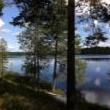-
Posts
71 -
Joined
-
Last visited
Reputation Activity
-
 Wim Dijkgraaf got a reaction from BrianCope in Out-of-the-box algorithms
Wim Dijkgraaf got a reaction from BrianCope in Out-of-the-box algorithms
I'm interested in having a complete list of the more high-level algorithms that Opusmodus supports out-of-the-box. This is what I found going through the integrated help documentation:
Lindmayer systems Cellular automata Working with pitch class sets Euclidean Algorithm Tonality mapping Mandelbrot sets Rubin (Rubin functions) Twelve-tone row (including All-interval twelve-tone row and Twelve Tone Forms) Klangreihen technique
Trobes (composer Joseph Hauer )
The Time Point System (Babbit)
Infinity Series (Nørgård)
Messiaen Permutation
Stravinsky Rotation
Brownian motion
Noise generation
Gaussian noise
Pink noise
White noise
Markov chain
Random generators (including random walk)
Schillinger Interference (Schillinger System of Music Composition)
Spectral Data
Wave forms (sine, sawtooth, square, triangle)
Any help to get this list complete is very much appreciated :-)
Big hug,
Wim Dijkgraaf
-
 Wim Dijkgraaf got a reaction from hujairi in Using a scheduler to do With Time Programming in Opusmodus
Wim Dijkgraaf got a reaction from hujairi in Using a scheduler to do With Time Programming in Opusmodus
Anyone using this or similar library to do 'Extempore-like' With Time Programming in Opusmodus?
https://github.com/byulparan/scheduler
Big hug
-
 Wim Dijkgraaf got a reaction from torstenanders in VSL converter -> Sibelius Sound Set to Opusmodus Sound Set
Wim Dijkgraaf got a reaction from torstenanders in VSL converter -> Sibelius Sound Set to Opusmodus Sound Set
Hi Torsten,
I've adjusted the source code and checked if it still works .. it does.
Just a short explanation of what I did to write the converter:
- used Microsoft XSD tool (included as xsd.exe) to auto generate a C# class from an XML file, with one of the Sibelius soundset files as input.
- I don't know to what degree that format is standardized. Might be that you encounter issues with EastWest files ... or maybe it just works. If both VSL and EastWest use the same XML elements, it should work.
- Wrote some classes with the logic to create Opusmodus Soundsets
- Added a console project that does the reading of Sibelius soundsets, calls the converter and serializes the result back to disc as an opusmodus soundset file.
The output from the converter is not 100% correct; meaning that you'll have to do some manual adjustments in Opusmodus to make sure that the soundset file is 100% Common Lisp 'compatible'. This due to some special characters that the converter doesn't handle correctly (yet) and which can't be used in Common Lisp symbols.
There is also some logic that maps VSL names to standard Opusmodus names that you'll have to adjust in order to be correct for the EastWest library.
I included the SibeliusSoundSet files for your convenience so you can make sure the solution works on your machine. It should be hassle free under Microsoft Visual Studio Community edition and above.
If I can be of some help, please let me know.
Big hug,
Wim Dijkgraaf
p.s. Wrote the code under time pressure and wanted to make sure first that the concept is viable. Should refactor the code :-) Even better ... re-write this code in Common Lisp running in Opusmodus ... :-)
-

-
 Wim Dijkgraaf got a reaction from opmo in Neo-Riemannian approach (Tonnetz, etc.)
Wim Dijkgraaf got a reaction from opmo in Neo-Riemannian approach (Tonnetz, etc.)
A little extra feature to play with:
(apply-tonnetz '(c4 e4 g4) '(l r n s p)) => ((c4 e4 g4) (b3 e4 g4) (b3 d4 g4) (c4 eb4 g4) (b3 eb4 fs4) (b3 d4 fs4))
Ability to not include a move in the output (by putting that move between parentheses):
(apply-tonnetz '(c4 e4 g4) '(l r n (s) p)) => ((c4 e4 g4) (b3 e4 g4) (b3 d4 g4) (c4 eb4 g4) (b3 d4 fs4))
-
 Wim Dijkgraaf reacted to AM in Looking for teacher / coach in Lisp Programming with Opusmodus
Wim Dijkgraaf reacted to AM in Looking for teacher / coach in Lisp Programming with Opusmodus
hi wim
so it is up to us to share ideas and code here in the forum :-)
greetings
andré
-
 Wim Dijkgraaf reacted to AM in Looking for teacher / coach in Lisp Programming with Opusmodus
Wim Dijkgraaf reacted to AM in Looking for teacher / coach in Lisp Programming with Opusmodus
Finally it is the question whether you want to generate music with the help of blackboxes/tools (whether open source or OM)... or you want to think, to reflect and to program your own ideas, and not to take what tools can easily generate (in this case you are not/less "independent"). with LISP (coding almost everything for myself) and OM for MIDI and SCORE it works for me... i think it's not a question of open source or not...
-
 Wim Dijkgraaf got a reaction from torstenanders in Neo-Riemannian approach (Tonnetz, etc.)
Wim Dijkgraaf got a reaction from torstenanders in Neo-Riemannian approach (Tonnetz, etc.)
I think it's working now. Have also removed workspace from source control. Guess that those paths to my file system are of no help to others :-)
-
 Wim Dijkgraaf got a reaction from JulioHerrlein in Opusmodus on a Windows Machine (using VMWare)
Wim Dijkgraaf got a reaction from JulioHerrlein in Opusmodus on a Windows Machine (using VMWare)
There you are :-)
-
 Wim Dijkgraaf got a reaction from lviklund in Triad inversion to root position intervals
Wim Dijkgraaf got a reaction from lviklund in Triad inversion to root position intervals
Have published the initial Tonnetz implementation (really bad code, has to be refactored and has some bugs):
https://github.com/willemdijkgraaf/ClTonnetz
Big hug
-
 Wim Dijkgraaf got a reaction from opmo in Neo-Riemannian approach (Tonnetz, etc.)
Wim Dijkgraaf got a reaction from opmo in Neo-Riemannian approach (Tonnetz, etc.)
Have published the initial Tonnetz implementation (really bad code, has to be refactored and has some bugs):
This is my first attempt ... still completely novice in Common Lisp.
https://github.com/willemdijkgraaf/ClTonnetz
Big hug
Thanks Torsten! Will check it out. I'm fluent in C#, Typescript and Javascript but will check it out anyway.
-
 Wim Dijkgraaf got a reaction from lviklund in Triad inversion to root position intervals
Wim Dijkgraaf got a reaction from lviklund in Triad inversion to root position intervals
Hi AM,
I'll share the code this weekend. Is written in a horrible way ... I'm really a beginner with Lisp and getting the concept to work is currently more important then writing the best Lisp code possible :-)
But hope that sharing will decrease the learning curve a bit.
Big hug
-
 Wim Dijkgraaf got a reaction from opmo in Triad inversion to root position intervals
Wim Dijkgraaf got a reaction from opmo in Triad inversion to root position intervals
Hi AM,
I'll share the code this weekend. Is written in a horrible way ... I'm really a beginner with Lisp and getting the concept to work is currently more important then writing the best Lisp code possible :-)
But hope that sharing will decrease the learning curve a bit.
Big hug
-
 Wim Dijkgraaf got a reaction from JulioHerrlein in Neo-Riemannian approach (Tonnetz, etc.)
Wim Dijkgraaf got a reaction from JulioHerrlein in Neo-Riemannian approach (Tonnetz, etc.)
I'm not an expert in Neo-Riemannian Theory at all but as a consequence of my Common Lisp study and writing of some functions to do Diatonic Neigbour Tones and Leading Tones, I bumped into this and it's kind of what I'm trying to accomplish musically.
Does Opusmodus have functions for this (implicitly or explicitly) or does anyone know of a Common Lisp library that is already specialized in Neo-Riemannian transformation? Basically the ability to do P R and L motions using elegant functions and calculating the shortest modulation (shortest Tonnetz steps) from any triad to any other triad.
One of the many explanations on youtube:
-
 Wim Dijkgraaf got a reaction from opmo in Opusmodus on a Windows Machine (using VMWare)
Wim Dijkgraaf got a reaction from opmo in Opusmodus on a Windows Machine (using VMWare)
There you are :-)
-
 Wim Dijkgraaf got a reaction from Yuichi Yamamoto in Opusmodus on a Windows Machine (using VMWare)
Wim Dijkgraaf got a reaction from Yuichi Yamamoto in Opusmodus on a Windows Machine (using VMWare)
There you are :-)
-
 Wim Dijkgraaf got a reaction from lviklund in Opusmodus on a Windows Machine (using VMWare)
Wim Dijkgraaf got a reaction from lviklund in Opusmodus on a Windows Machine (using VMWare)
There you are :-)
-
 Wim Dijkgraaf got a reaction from opmo in Opusmodus on a Windows Machine (using VMWare)
Wim Dijkgraaf got a reaction from opmo in Opusmodus on a Windows Machine (using VMWare)
My first impression is yes it is. The eLicenser that Vienna software needs doesn't work under VMWare. But since Vienna can work with any MIDI input device I created a setup using MIDI over ethernet. VMWare's network settings can be set to Bridged so that the host and the slave have their own IP addresses on the same network. Works perfectly :-)
-
 Wim Dijkgraaf got a reaction from Yuichi Yamamoto in Opusmodus on a Windows Machine (using VMWare)
Wim Dijkgraaf got a reaction from Yuichi Yamamoto in Opusmodus on a Windows Machine (using VMWare)
I've been working on running OSX on a windows machine using VMWare; works really well! Simple procedure if you follow these steps:
https://www.pcsteps.com/2157-mac-os-x-virtual-machine-vmware-player/
Wouldn't recommend this setup for OSX applications that really need high performance graphics (using Quartz for example) but for using Opusmodus on a Windows machine this could be a nice option for those not able/wanting to invest in Apple hardware.
If you install rtpMIDI on the windows machine you'll also be able to run your audio software under Windows and connect Opusmodus using MIDI over a virtual network connection.
Big hug,
Wim Dijkgraaf
-
 Wim Dijkgraaf got a reaction from opmo in Opusmodus on a Windows Machine (using VMWare)
Wim Dijkgraaf got a reaction from opmo in Opusmodus on a Windows Machine (using VMWare)
I've been working on running OSX on a windows machine using VMWare; works really well! Simple procedure if you follow these steps:
https://www.pcsteps.com/2157-mac-os-x-virtual-machine-vmware-player/
Wouldn't recommend this setup for OSX applications that really need high performance graphics (using Quartz for example) but for using Opusmodus on a Windows machine this could be a nice option for those not able/wanting to invest in Apple hardware.
If you install rtpMIDI on the windows machine you'll also be able to run your audio software under Windows and connect Opusmodus using MIDI over a virtual network connection.
Big hug,
Wim Dijkgraaf
-
 Wim Dijkgraaf got a reaction from Stephane Boussuge in Opusmodus on a Windows Machine (using VMWare)
Wim Dijkgraaf got a reaction from Stephane Boussuge in Opusmodus on a Windows Machine (using VMWare)
I've been working on running OSX on a windows machine using VMWare; works really well! Simple procedure if you follow these steps:
https://www.pcsteps.com/2157-mac-os-x-virtual-machine-vmware-player/
Wouldn't recommend this setup for OSX applications that really need high performance graphics (using Quartz for example) but for using Opusmodus on a Windows machine this could be a nice option for those not able/wanting to invest in Apple hardware.
If you install rtpMIDI on the windows machine you'll also be able to run your audio software under Windows and connect Opusmodus using MIDI over a virtual network connection.
Big hug,
Wim Dijkgraaf
-
 Wim Dijkgraaf got a reaction from Yuichi Yamamoto in Development Environment / IDE / Editor
Wim Dijkgraaf got a reaction from Yuichi Yamamoto in Development Environment / IDE / Editor
Anyone using Emacs or LispBox for Opusmodus specific development or any other environment that might be more productive for a professional developer to work in than the standard Opusmodus environment?
Big hug,
Wim Dijkgraaf
-
 Wim Dijkgraaf got a reaction from opmo in Tonality mapping and chromatic leading tones
Wim Dijkgraaf got a reaction from opmo in Tonality mapping and chromatic leading tones
Thanks both of you for the interesting approaches. Unfortunately I'm too busy at the moment finalising a project for a client but will have a closer look at this soon. I'm also heavily studying Lisp hand hope to be able to come-up with a couple of functions that does the job AND looks sufficiently elegant to reflect the musical idea.
Will be continued soon I hope :-)
-
 Wim Dijkgraaf got a reaction from Stephane Boussuge in Tonality mapping and chromatic leading tones
Wim Dijkgraaf got a reaction from Stephane Boussuge in Tonality mapping and chromatic leading tones
Thanks both of you for the interesting approaches. Unfortunately I'm too busy at the moment finalising a project for a client but will have a closer look at this soon. I'm also heavily studying Lisp hand hope to be able to come-up with a couple of functions that does the job AND looks sufficiently elegant to reflect the musical idea.
Will be continued soon I hope :-)
-
 Wim Dijkgraaf got a reaction from Stephane Boussuge in Tonality mapping and chromatic leading tones
Wim Dijkgraaf got a reaction from Stephane Boussuge in Tonality mapping and chromatic leading tones
Some examples:
Source material (think a C major triad with chromatic lower neighbors) c4 ds4 e4 fs4 g4 b4 c5.
tonality set to D dorian or aeolian: Outcome should be: d4 e4 f4 gs4 a4 cs5 d5
tonality set to D locrian: Outcome should be: d4 e4 f4 g4 gs4 cs5 d5.
tonality set to D augmented/whole tone: Outcome should be: d4 f4 fs4 a4 as4 cs5 d5
I think the requirement I have is something like this:
When setting the source material, the tonality of the source material is also specified. OM interprets all pitches that are not part of the source tonality as chromatics. When the source material is mapped on another tonality, those chromatics are not changed but will be transposed according to the diatonic pitch 'it is related to'. For chromatic leading tones, the "pitch it is related to" will be the next pitch that is part of the source tonality.
For chromatic upper neighbors, the "pitch it is related to"will be the previous pitch that is part of the source tonality.
I'm sorry if this requirement isn't described very clearly. If needed, can do a new attempt :-)
Kind regards,
Wim Dijkgraaf


.jpg.e9f9cf75853400e41decfbb95b5787d5.thumb.jpg.9228dc058ca75cbec8d8dd1565ccc593.jpg)




